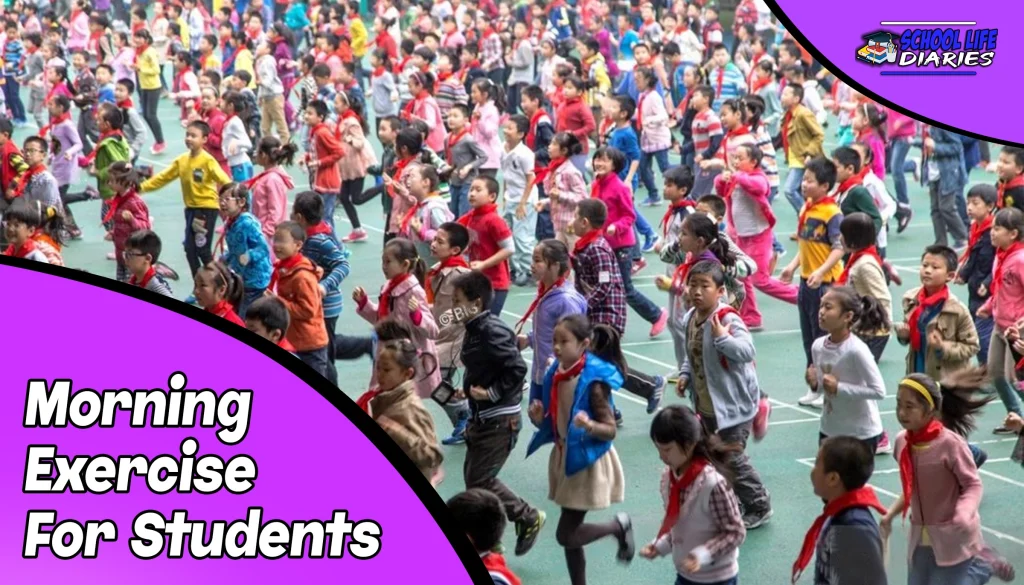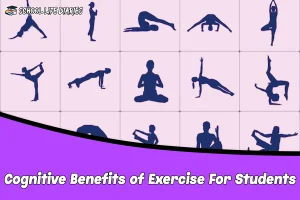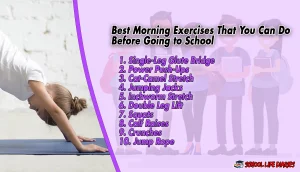In today’s fast-paced world, students often struggle to balance academic commitments with maintaining a healthy lifestyle. One of the most effective ways to promote physical and mental well-being is by incorporating regular morning exercise for students into their daily routines.
While exercising at any time of the day has its benefits, morning exercise has been shown to have unique advantages for students. Research suggests that morning exercise can boost metabolism, increase energy levels, and improve cognitive function throughout the day.
Why Students Should Exercise in the Morning?
Engaging in morning exercise routines has been shown to provide numerous benefits for students, making it an advantageous activity that can positively impact their academic and personal lives. First and foremost, incorporating exercise into a daily routine has been proven to increase productivity in individuals of all ages.
This is especially relevant for students, as they are expected to balance coursework, extracurricular activities, and social lives while maintaining high levels of academic achievement. By starting their day with exercise, students can improve their concentration and mental clarity throughout the day.
Moreover, morning exercise routines have also been linked to improved mental health outcomes. With the rise of stress and anxiety among young people in recent years, finding ways to manage these feelings is crucial. Exercise releases endorphins that promote positive emotions such as happiness and euphoria.
Engaging in morning exercises can help students develop better time management skills. Incorporating a consistent routine into one’s day requires planning and discipline – two qualities that are essential for success both inside and outside the classroom.
As many students struggle with procrastination or lack of motivation when it comes to managing their time effectively, implementing a daily workout regimen can be an effective way to establish healthy habits that promote productivity.
What If Students Have Limited Time in the Morning For Exercise?
With time constraints in the morning, it can be challenging for individuals to fit into a physical activity routine. However, there are ways to manage time and still incorporate exercise into daily routines. One way is by opting for quick workouts that can be completed in as little as 15 minutes.
These exercises could include squats, lunges, push-ups, and planks. Another option is investing in exercise equipment that can be used at home. This could include resistance bands, dumbbells, or even a yoga mat. Having these tools readily available at home eliminates the need to commute to a gym or fitness center and saves valuable time.
Time management is crucial when trying to incorporate morning exercise into daily routines with limited time. By prioritizing this aspect of one’s life and making small adjustments such as waking up earlier or prepping workout gear the night before, it becomes easier to stick with an exercise routine.
Can Morning Exercise Improve Academic Performance?
Research has shown a positive correlation between physical activity and cognitive function, suggesting that incorporating regular exercise into one’s routine may lead to improved academic performance. In fact, a study conducted by the University of Illinois found that children who participated in a 70-minute aerobic exercise program showed increased attention and concentration, as well as better performance on tasks requiring executive control compared to those who did not participate in the program.
This suggests that incorporating morning exercise into a student’s daily routine could have significant academic benefits. Creating an effective morning exercise routine can be challenging for students with busy schedules. Time management skills can help make it possible to incorporate healthy habits into their morning routines.
By waking up earlier or adjusting their schedules accordingly, students can carve out time for physical activity before starting their day. This will not only improve their physical health but also set them up for success academically.
Cognitive Benefits of Exercise For Students
Regular physical activity has been linked to improved cognitive function in individuals, providing a compelling reason for individuals to prioritize their health and well-being. Exercise can enhance brain function by increasing blood flow and oxygen delivery to the brain.
It also promotes the growth of new nerve cells, which can improve memory retention and learning ability. In addition to improving brain function, exercise can also enhance mood and attention span. Physical activity releases endorphins, which are feel-good chemicals that help reduce stress and anxiety levels.
This can lead to an overall improvement in mood and mental well-being. By promoting brain function, memory retention, mood enhancement, attention span, and learning ability, students may see an improvement in academic performance as well as an overall improvement in their quality of life.
Physical Benefits of Exercise For Students
Physical activity can lead to improvements in overall physical health and well-being for individuals. Regular exercise can enhance physical endurance, which is the ability to sustain physical activity for prolonged periods. Physical endurance is important for students as it enables them to engage in activities that require stamina, such as sports or long study sessions.
Exercise also promotes motor performance, which refers to an individual’s ability to execute specific movements efficiently. This can be beneficial for students who need to engage in activities that require precision and accuracy. In addition to improving physical health, exercise has been linked with positive effects on mental alertness and emotional wellness.
Studies have shown that regular exercise can improve cognitive function and reduce symptoms of anxiety and depression. For students, this means that engaging in morning exercises can help them start their day with a clear mind and a positive attitude toward learning.
Exercise plays a crucial role in promoting cardiovascular health. Daily morning exercises can help improve blood flow throughout the body while reducing the risk of heart disease. Cardiovascular fitness is essential for individuals of all ages but is particularly important for students as they undergo various stressors during their academic journey.
Best Morning Exercises That You Can Do Before Going to School
This subtopic discusses the best morning exercises that students can do before heading to school. These exercises include the single-leg glute bridge, power push-ups, cat-camel stretch, jumping jacks, and inchworm stretch.
Incorporating these exercises into a daily morning routine can help improve overall health and well-being while also providing an energy boost for the day ahead.
1. Single-Leg Glute Bridge:
The Single Leg Glute Bridge is an effective exercise for students to perform as part of their morning routine. This bodyweight exercise helps with glute activation, muscle imbalances, and core stability. By lifting one leg off the ground and engaging the glutes to lift the hips up toward the ceiling, students can improve their overall fitness.
Proper exercise form is important when performing the Single Leg Glute Bridge. Students should focus on keeping their core engaged throughout the movement and maintaining a straight line from their shoulders to their knees. Progressions and regressions can also be used to make this exercise more challenging or easier depending on individual fitness levels.
2. Power Push-Ups:
Power Push Ups are a demanding upper-body exercise that requires strength, stability, and coordination. This exercise is a variation of the traditional push-up and involves explosive movements that engage multiple muscle groups. To perform Power Push Ups, start in a plank position with your hands shoulder-width apart and your feet hip-width apart.
Lower yourself towards the ground until your chest almost touches the floor, then forcefully push yourself back up into the starting position while clapping your hands together before landing back on the ground. Proper form is essential when performing Power Push Ups to avoid injury and maximize results.
Keep your core engaged throughout the movement to stabilize your body, maintain a straight line from head to toe, and breathe deeply as you lower yourself toward the ground. This exercise targets several muscle groups including the chest, triceps, shoulders, and core muscles.
The benefits of incorporating Power Push Ups into your morning exercise routine include increased upper body strength and endurance, improved posture and balance, enhanced cardiovascular fitness levels, and an overall boost in energy for the day ahead.
3. Cat-Camel Stretch:
Engage your core and slowly alternate between arching your back upwards and downwards in the Cat-Camel Stretch, a simple yet effective exercise for improving flexibility and relieving tension in the spine. Proper technique is crucial to reap the benefits of this stretch.
Start on all fours with your hands directly under your shoulders and knees under your hips. Inhale deeply as you lift your head up towards the ceiling, allowing your spine to curve into an arch or ‘cat’ position. Exhale as you reverse the movement, lowering your head down towards the floor while rounding your spine into a ‘camel’ position.
The benefits of practicing cat-camel stretch are numerous. It helps improve posture by strengthening key muscle groups such as those in the lower back, abdomen, and neck region. Variations include holding each position for several breaths before transitioning to another pose or adding gentle movements such as swaying from side-to-side while in camel pose.
4. Jumping Jacks:
Jumping jacks are a classic exercise that can be easily incorporated into any workout routine. This high-intensity cardio move involves jumping while simultaneously spreading the arms and legs apart, making it an effective way to get your heart rate up and burn calories.
Proper form is essential when performing jumping jacks; start with your feet together and arms at your sides, then jump up while spreading your legs wide and raising your arms above your head. Land softly on the balls of your feet as you bring your arms back down to your sides.
5. Inchworm Stretch:
The inchworm stretch is a dynamic exercise that targets several muscle groups, including the hamstrings, glutes, and core muscles. It involves starting in a standing position and then bending forward to touch your hands to the ground before walking them out into a plank position.
From there, you walk your feet up toward your hands and stand back up. One of the benefits of the inchworm stretch is that it can improve flexibility and mobility in these targeted muscle groups. To perform this exercise correctly, keep your hips stationary when walking out into a plank position and engage your core muscles throughout the movement.
It’s recommended to incorporate this exercise into your routine 2-3 times per week along with other morning exercises such as jumping jacks or stretching routines for optimal results.
6. Double Leg Lift:
To perform the double leg lift, core strength is crucial. Lie flat on your back with your arms at your sides and both legs extended upwards. Engage your abdominal muscles to lift both legs towards the ceiling, focusing on maintaining proper form throughout the movement.
Keep your lower back pressed into the ground and avoid arching it as you lift. Proper muscle activation is essential for maximizing the benefits of this exercise. To further engage your core muscles, hold for a few seconds at the top of each repetition before slowly lowering your legs back down to starting position.
7. Squats:
Moving on from the double leg lift, another effective morning exercise for students is squats. Squatting is a compound movement that targets multiple muscle groups such as the quadriceps, hamstrings, glutes, and calves. There are various squat variations that can be performed depending on the fitness level and goals of the individual.
Some popular squat variations include front squats, back squats, goblet squats, sumo squats, and jump squats. Proper form is crucial when performing any type of squat variation to avoid injury and maximize results. To perform a basic bodyweight squat correctly, stand with feet shoulder-width apart and toes slightly pointed outwards.
Keep your chest up and engage your core muscles while bending your knees and lowering yourself down until your thighs are parallel to the ground or lower. Push through your heels to return to a standing position.
8. Calf Raises:
Calf raises are a simple yet effective exercise that can be incorporated into a daily routine to strengthen and tone the calf muscles. To perform this exercise, one should start by standing with their feet hip-width apart and placing their hands on their hips or holding onto a sturdy object for balance.
Then, they should raise up onto the balls of their feet as high as possible while maintaining proper form, which includes keeping the core engaged and avoiding any leaning forward or backward. There are several variations of calf raises that can be performed depending on fitness level and desired intensity.
One variation is single-leg calf raises, where one foot is lifted off the ground while performing the exercise with the other foot. The benefits of incorporating calf raise into one’s morning exercise routine include improved ankle stability, increased muscle strength, and better overall balance.
9. Crunches:
One effective exercise for strengthening the abdominal muscles is crunched, which involves lying on one’s back with knees bent and feet flat on the ground while lifting the upper body towards the ceiling. Proper form is essential when performing crunches to avoid straining the neck or lower back.
To maintain proper form, individuals should keep their chin tucked in and focus on using their abdominal muscles to lift their upper body rather than relying on momentum. There are several variations of crunches that can be incorporated into a morning exercise routine to prevent boredom and target different areas of the abdominals.
Some popular variations include bicycle crunches, reverse crunches, and side plank oblique crunches. Individuals should aim to perform 2-3 sets of 10-15 repetitions of each variation at least twice per week while being mindful of any challenges or limitations they may have.
10. Jump Rope:
Jump rope is a simple and effective cardiovascular exercise that can be easily incorporated into a fitness routine. With the right technique, it can provide numerous benefits such as improved coordination, agility, and endurance.
When it comes to jumping rope techniques, there are various styles that one can try such as basic jumps, high knees, crisscrosses, and double-unders. Before attempting any advanced moves, it’s important to master the basics first.
How Can Students Stay Motivated to Exercise in the Morning?
To maintain motivation for morning exercise, students can establish a routine that includes specific goals and rewards, as well as accountability through an exercise partner or group. Motivational strategies are essential when it comes to maintaining a workout routine. Setting achievable goals is one way to stay motivated.
For instance, students can aim to run a mile in under ten minutes or complete 50 jumping jacks within two minutes. Creating a morning routine that incorporates exercise is another effective way to stay motivated. Students should set aside time every day for physical activity and treat it as an essential part of their daily regimen.
Establishing a rewards system is also helpful in motivating students to continue with their morning workout routine. A small incentive such as treating oneself to a smoothie after exercising can go a long way in keeping students on track with their fitness goals.
Conclusion:
Regular morning exercise has numerous benefits for students, including improved cognitive function and physical health. While it may be challenging to find time for exercise in the morning, even a short workout can have significant benefits.
Incorporating simple exercises into your daily routine such as jogging or stretching can help improve blood flow throughout the body and boost energy levels for the day ahead.
Moreover, engaging in physical activity in the morning can also help reduce stress and anxiety while improving overall mental well-being.







